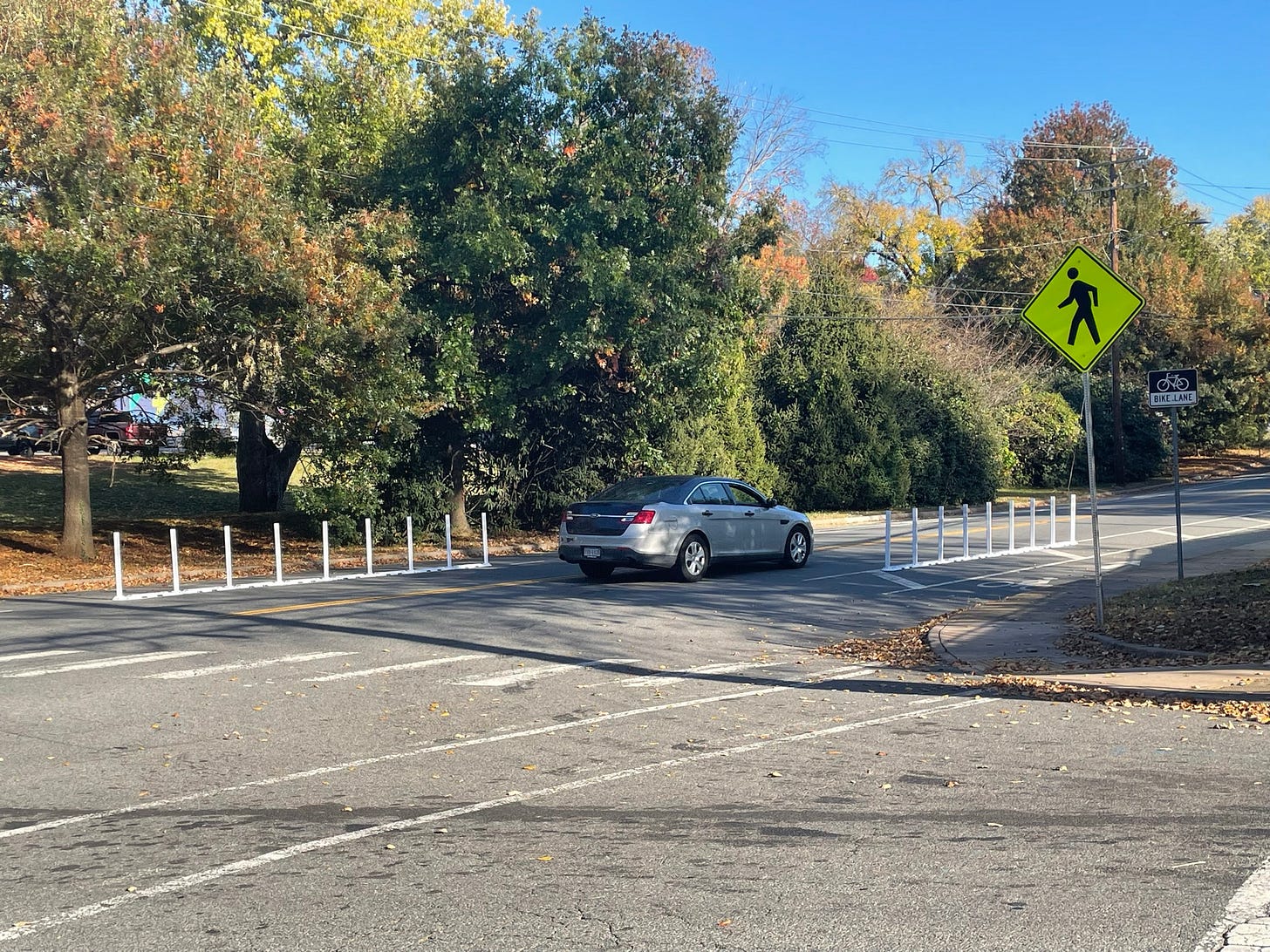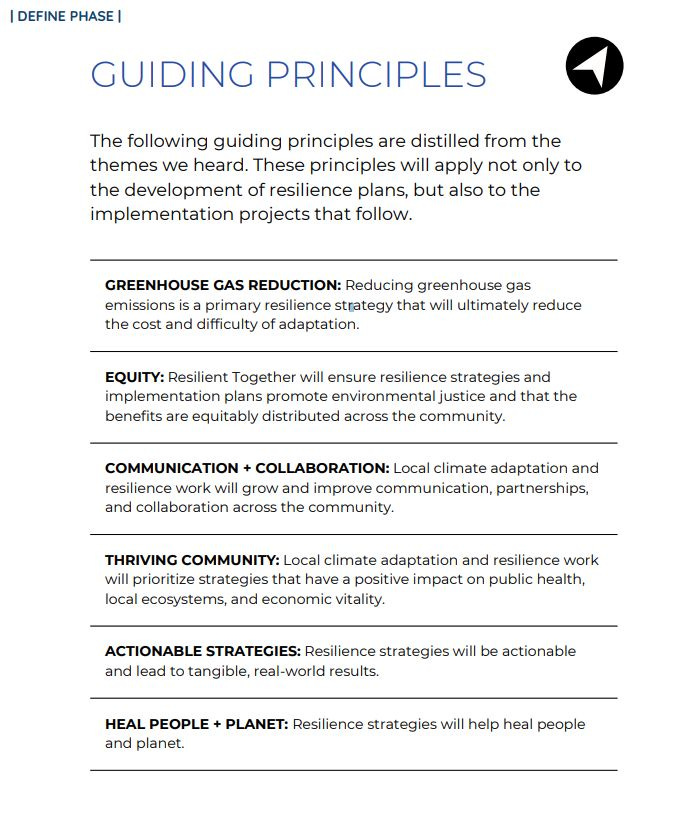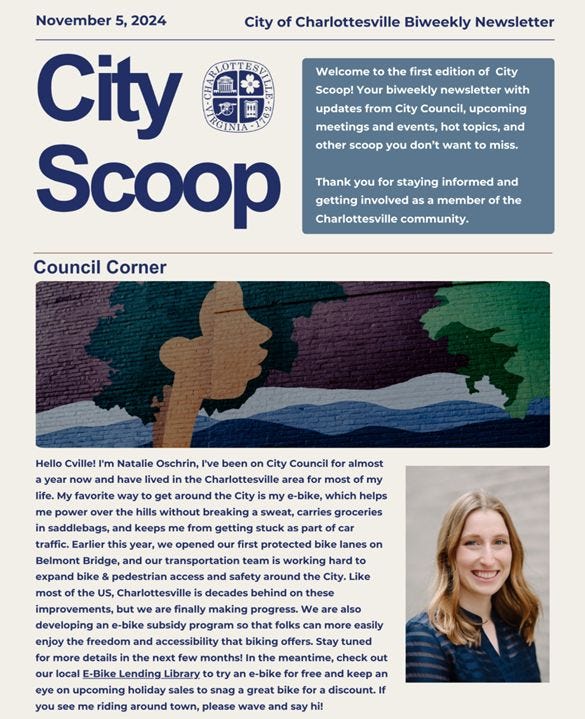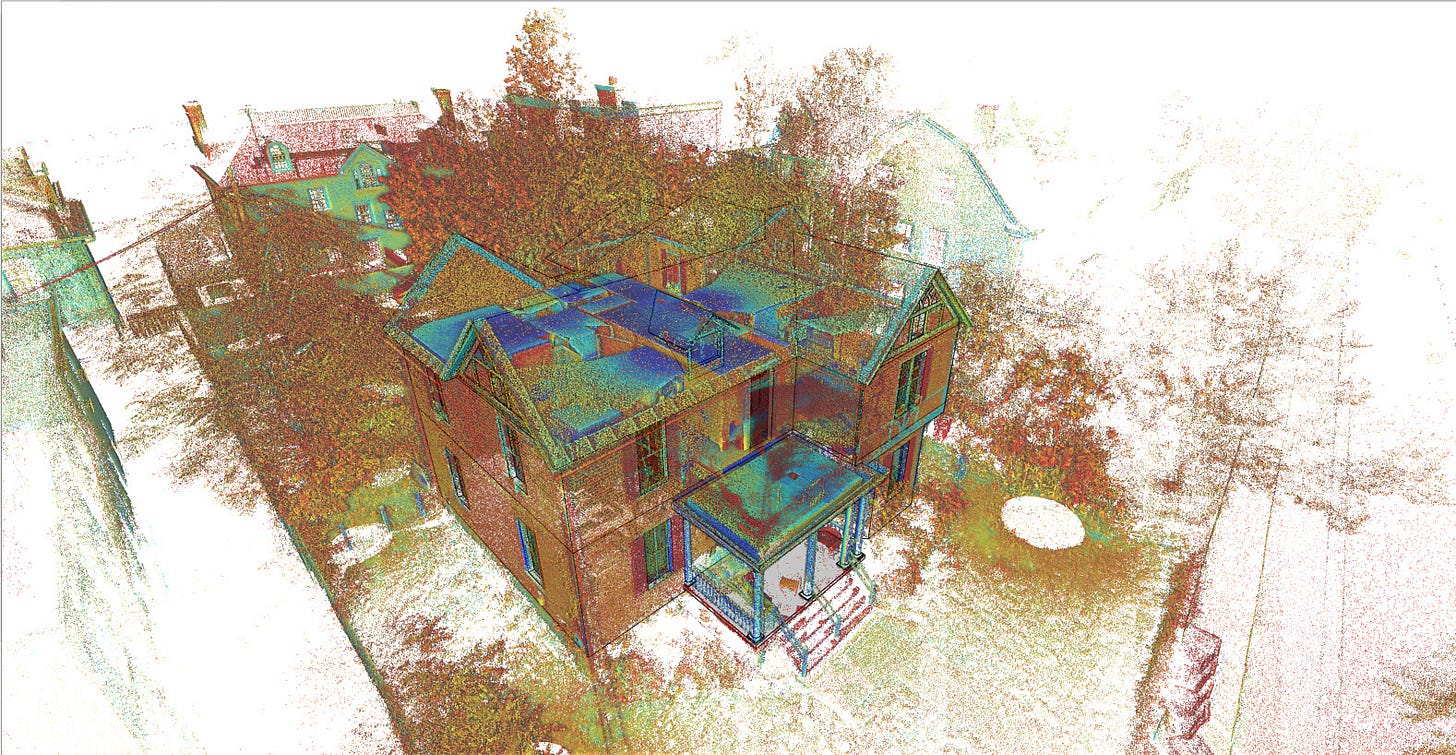November 5, 2024: “Urgent infrastructure dollars” to be deployed to address safety concerns on Elliott Avenue in Charlottesville
Plus: The Albemarle County and Charlottesville Planning Commissions meet for the first time in several years
It will not be difficult to remember the Fifth of November on this day because you’re standing on it! But, if it helps, remember again!
On this day 419 years ago in London, authorities of King James arrested Guy Fawkes while he guarded a cache of explosives intended to blow up Parliament. Humanity’s time in the global spotlight is filled with such examples of factions that decide they dislike each other to the point where violence kicks in. Charlottesville Community Engagement is an attempt to do something completely different. I’m Sean Tubbs, and I still believe.
In today’s edition:
Charlottesville’s Deputy City Manager for Operations says the city intends to do something to address pedestrian safety on Elliott Avenue in the wake of a death at an unlit crosswalk in early October
Charlottesville is also seeking firms to conduct a routine audit of Jaunt
Council agrees to refund over $10,000 to the UVA Foundation for a water leak at a property for one of their many properties on Arlington Boulevard
The first issue of Charlottesville’s in-house digital newsletter is out
Albemarle and Charlottesville’s planning commissions met for the first time in several years in late October to get a briefing on creation of climate resilience plans
First-shout: Piedmont Master Gardeners seeking applicants for extension training program
Would you like to deepen your knowledge of gardening and share it with the community in fun and rewarding ways? Then apply to join the 2025 training class for Master Gardener volunteers serving Charlottesville and Albemarle County.
Running from January into April, the 2025 class will be presented in a hybrid format, combining online sessions every Tuesday evening with in-person workshops every other Saturday. The 2026 class will be an entirely in-person format.
The 70 hours of instruction will cover topics ranging from vegetable gardening, ornamental gardening, and fruit growing to soil health, wise water use, and disease and pest management. Find further details here.
The deadline to apply is December 1.

Charlottesville to make plans to improve pedestrian safety on Elliott Avenue
Last night, Charlottesville City Council heard an earful from several speakers about the lack of infrastructure to make it safer for people to cross Elliott Avenue.
“I am here today because bad design kills and it has killed people on Elliot Avenue, and it will continue to kill people on Elliot Avenue,” said Renee Byrd, the creator of a petition made in the wake of the death of 64-year-old Mamawa Samai on October 3.
Byrd’s petition calls for a second crosswalk to be built at Elliott Avenue and 2nd Street and said the hundreds of people who have signed digital and paper versions of the petition expect a fix to be made.
“We all know that this is a very dangerous crossing and it's a legal crossing, which hopefully most people know,” Byrd said, “But without actually having a marked crosswalk there, we are so much more endangered by cars who don't realize people are crossing because they cannot see people crossing at this space for a lot of different reasons.”

Several other people spoke to the issue including Belmont resident Chelsea Braun whose husband was once hit on a bicycle while in a crosswalk. She said this was a public health issue.
“I'm a professor of medicine at UVA,” said Dr. Braun. “I used to bike commute to work. It became too stressful and too dangerous for me to ride my bicycle from Belmont to UVA because of hostile, aggressive drivers and lack of infrastructure.”
James Freas, Charlottesville’s Deputy City Manager of Operations, said the city quickly installed plastic bollards at the intersection where Samai was fatally struck in order to draw more attention to the crossing.
“I want to acknowledge that those were the solutions that we could do quickly,” Freas said “Those are what we could do within a matter of days. But that doesn't mean we are done with that work at this point in time.”
Freas said his staff is working to identify more permanent solutions that can be constructed within a year.
“The city manager has identified what we're referring to as urgent infrastructure dollars that can be put towards these deployments very quickly,” Freas said.
Earlier in the meeting, Council got a briefing from city transportation staff on the status of several projects in the planning stages and on the city’s ability to build projects. I’ll have that story in a future edition of the newsletter. For previous stories on transportation in the area, visit this link to Information Charlottesville.
Charlottesville seeks firm to audit Jaunt
There are three major transit providers in the Albemarle/Charlottesville community, and the City of Charlottesville is seeking a firm to ensure one of them is in compliance with federal procurement laws.
“The City of Charlottesville is soliciting sealed proposals from qualified vendors for the performance of a compliance review of Jaunt, Inc.'s complementary paratransit service,” reads an RFP issued on November 1. “This compliance review will aid CAT in ensuring that Jaunt's paratransit service provides all required services and maintains regulatory compliance as appropriate.”
Bids are due on December 1 and the initial audit and review are due on March 2025.
The federal Americans with Disabilities Act of 1990 requires any agency that provides a fixed-route bus system must also provide a paratransit service which means individualized trips to help people in need get around the community.
“Jaunt's paratransit service provides door-to-door transportation services for customers whose disabilities prevent them from using CAT's fixed-route service,” reads the background of the RFP.
People who are within three quarters of a mile of a bus stop are eligible for rides. Jaunt has both a reservations system where people can book rides two weeks in advance as well as subscription service to allow for regular pick-ups.
Jaunt is a public service corporation founded in 1975 and owned by the local governments that fund the agency. Its Board of Directors are appointed by the other localities that hire the company for public transportation services.
Charlottesville is contributing $1,933,090 to Jaunt in the fiscal year that began on July 1, with much of that being a pass-through of federal funds the city receives to ensure the ADA-requires service is provided.

Council approves credit to UVA Foundation for water leak
The University of Virginia Foundation purchased the apartment complex at 1982 Arlington Boulevard in June 2020 for $10 million. The complex had been owned by Woodard Properties since 1983.
Recently there was a water leak at the building that resulted in usage 16 times the regular amount and repairs were made.
“Per the City’s leak credit procedures, the customer has requested a credit to their water and wastewater accounts for this location,” reads a staff report for an item on the consent agenda of last night’s City Council meeting.
The amount calculated to $10,887.26 and Council must approve any credit over $10,000. Council did so last night with no comment.
The UVA Foundation is in the process of consolidating properties along Arlington Boulevard. On May 31, an entity tied to the Foundation called “Arlington Boulevard of Charlottesville LLC” paid $10.5 million to the University of Virginia Credit Union for 1932 Arlington and 1936 Arlington.
On December 30, 2019, the University of Virginia Foundation paid $10 million for 2102 and 2106 Arlington Boulevard.
The 66.2 acres immediately to the southwest of Arlington Boulevard are owned by the University of Virginia outright, which means they are technically in Albemarle County and planning is conducted in-house and behind closed doors.
The consolidation of properties along Arlington Boulevard is similar to the process used to slowly convert properties on Ivy Road, Emmet Street, and Brandon Avenue into future UVA properties which are not subject to local zoning control, local taxation, or local planning requirements.

First issue of CityScoop is live
The City of Charlottesville’s Communications Department has published the first edition of a biweekly digital newsletter called City Scoop.
“It is meant for you,” said City Manager Sam Sanders at the November 4, 2024 City Council meeting. “You can request what goes in it so we are looking forward to hearing back from the public on things they have an interest in.”
The inaugural issue has a welcome from City Councilor Natalie Oschrin and other various pieces of information. However, the blurb on how the city is seeking performers for the Grand Illumination does not feature an example by anyone who works in City Hall, unlike this work by an independent journalist.
There will also be print copies in City Hall, public libraries, and various places on the Downtown Mall.
To sign up for City Scoop, visit the city’s website.
Second-shout out: Design Develop
In today’s Patreon-fueled shout-out, architectural firm Design Develop is offering a new service aimed at the development community that the rest of us might want to know about , too — 3D point cloud scanning! This technique uses specialized equipment, such as 3D scanner systems, to gather a large amount of data points that represent the surface of the scanned object or scene. This really comes in handy when working with historic structures, as the firm knows from its experience in Baltimore and Charlottesville. Read their blog post for more information!
The applications of 3D point cloud scanning are extensive and cover various fields, including architecture, construction, cultural heritage preservation, virtual reality, industrial design, manufacturing, and more. These applications require accurate 3D spatial information, and Design Develop’s workflow provides precise and comprehensive results, all while being more cost-effective than traditional methods.
Design Develop has expertise in this workflow for their own needs and now has a dedicated team offering this service in the Charlottesville and Albemarle Area. If you're involved in the real estate, design, or construction industry, contact them for more information or a free quote.
Visit their website for an introductory video that captures the 3D point cloud scanning of the Downtown Transit Center and a booklet that will explain more!
If Albemarle and Charlottesville plan together, can that help the community adapt to climate change?
(First of two parts)
The Albemarle and Charlottesville Planning Commissions have not held a meeting in nearly eight years, but when they reconvened this past Tuesday the topic was both broad and important.
“Climate change, of course, is an existential issue that we face as a community, and we have to do something that's broader than just our individual jurisdictions so I’m excited to have this opportunity,” said Michael Barnes, Albemarle County’s Planning Director.
The chair of the Albemarle Planning Commission is Fred Missel who works in his day job as director of development for the University of Virginia Foundation. He said it was good to meet many people for the first time at the meeting.
“We often times get in our little silos where we're working on our own projects and our own spaces, whether it's the University, the county, the city, or others,” Missel said. “This is obviously not one of those subjects that we should be siloed in.”
Staff from Albemarle, Charlottesville, and UVA gave an update on Resilient Together, a project intended to result in development of resilience plans for the community to adapt to climate change and reduce greenhouse gas emissions. The work is funded in part by a $460,000 grant from the U.S. Environmental Protection Agency.
Engagement for the project began last year and so far there have been three phases
Emily Irvine, the climate program manager for Charlottesville, began the presentation by describing some of the risks and hazards central Virginia faces as a result of a shifting climate.
“Many folks think of climate change as a future hazard,” Irvine said. “I do think as we witness impacts and natural disasters around the globe and around the country, and most recently in our own state and our neighboring state, it is really becoming more present for people because we are being impacted now and we will continue to be more impacted in the future.”
Both Albemarle and Charlottesville have conducted risk and vulnerability assessments and Irvine said extreme heat is one of the biggest threats. Extreme heat is considered to be when the temperature is above 95 degrees Fahrenheit.
“Our historical average was that we experienced about five days of extreme heat every summer,” Irvine said. “I think we saw more days than that this past summer. By mid century, we expect to see nearly a month of these extremely hot days each summer. And by 2075, we could see nearly two months of these extremely hot days.”
Irvine said other impacts are increased periods of drought. Before Hurricane Helene hit, the region was in a drought watch followed by intense periods of rain. Since then, almost no rain with only 0.37 of an inch recorded in Charlottesville for the entire month of October.
Shifting weather patterns mean different species are able to thrive here and creatures like risks and mosquitoes are able to live for longer periods, putting people in danger. Poison Ivy is stronger because its toxins are become more concentrated when there is more carbon dioxide in the air. Another hazard recently identified is the effect of more smoke from wildfires, which are also more common.
“I think everyone in this room can probably remember last summer and fall when we had smoke from Canadian wildfires, smoke from other fires in the region that were really impacting our community,” Irvine said. “And so children, older folks, folks with pre existing conditions, our homeless neighbors, folks who work outside, are particularly impacted by this decrease of our regional air quality.”
Gabe Dayley is Irvine’s counterpart in Albemarle as the county’s climate action program manager. He said the Resilient Together project came out of a conversation with Irvine’s predecessor.
“Hey, you know, we're doing these climate vulnerability and risk assessments, we're starting to see more of these impacts,” Dayley said. “You know, should we be thinking about working together between our two jurisdictions and University of Virginia on resilience planning process for the community? Because, you know, the extreme rain and flooding event or the heat wave doesn't particularly care where the jurisdictional boundary is.”
Under Resilient Together, both Albemarle and Charlottesville will develop a plan to adapt to climate change. Implementing the plans will require working across two localities that have two separate chains of command, two separate elected bodies, two separate zoning codes, and two Comprehensive Plans.
“We've actually had the sort of fruitful opportunity to be doing our resilience planning in concurrence with the AC44 comprehensive plan update so we've been able to have a lot of cross pollination with our colleagues in planning,” Dayley said.

As with most plans, there are guiding principles that inform the work of Resilient Together. The top one listed is for Greenhouse Gas Reduction. Albemarle Planning Commissioner Nathan Moore said that adaptation might be a more pressing concern.
“We could be carbon neutral tomorrow in Charlottesville and Albemarle County and it's still going to be 30 days a year that are over 95 in 2050,” Moore said. “I feel like if we let that take up the air in the room of the primary strategy, then we're going to miss out on the sort of social things and the actual adaptation things that are much more necessary.”
Moore said priorities need to be on strengthening the power grid, providing back-up systems, ensuring there’s enough water, and improving communications during hazard events.
Charlottesville Planning Commissioner Betsy Roettger said it is not too early to be providing some sense of how much some of the adaptive measures might cost in part so different groups could seek funding for different aspects.
“I think it also helps when talking to communities, having the money up there so that people can help figure out, like, oh, okay, if we do this, maybe we can't do that,” Roettger said. “Sometimes we leave that out and then people are disappointed because we choose something else and they don't understand why.”
Albemarle Planning Commissioner Lonnie Murray pointed out there is a tension between some efforts to reduce greenhouse gasses and efforts to save endangered species.
“We're massively losing biodiversity on a worldwide basis and I know Albemarle County has a biodiversity action plan,” Murray said. “I think we stand apart by having that in our county.”
However, Murray pointed out that many communities are sacrificing biodiversity by approving too many solar fields without considering the impact on natural systems.
Dayley said the resilience plans will help balance the many priorities and his office weighs in on solar development proposals in Albemarle.
Charlottesville Planning Commission Phil d’Oronzio said he felt resilience plans need to have an implementation strategy developed concurrently as the documents are put together.
“If we're not mindful of the process of the implementation and how this is going to roll out and what it's going to look like, I think we could end up in sort of a frozen, constipated space where some of this doesn't get done,” d’Oronzio said. “So I'm a little concerned about that.”
Albemarle Commissioner Corey Clayborne said he just wished the two Planning Commissions would meet more often. Both Clayborne and fellow Albemarle Commissioner Karen Firehock both have the distinction of serving on the city’s planning commission. Clayborne said the documents have to state clearly the costs of doing nothing.
“It could even be life expectancy,” Clayborne said. “Like if we do nothing, life expectancy in this region changes from 72 to 69, whatever it might be. But I do think that economics and health are two really important points that measure the vitality of a community.”
Charlottesville Planning Commissioner Lyle Solla-Yates said he wanted to know more about the role housing and public transportation, but pointed out that many rules at the state level need to be changed.
“We've been having troubles with legislative authority to police this changing climate,” Solla-Yates said. “Our rules are old at the state level and we are constricted within them. It's going to take us a long time to fix that, but I suggest legislative reform.”
At an hour and a half into the conversation, Missel asked if the planners are actively thinking about how to pay for many of the strategies. Irvine said that is a goal of the joint planning effort.
“This is a unique thing that we're doing here together,” Irvine said. “Two jurisdictions and a university that spans our our jurisdictions. We're working together. So when you think about grant applications, that's a unique structure, a unique way of working together. So we've been thinking about it in that context, like, how can we sort of use this partnership to leverage outside resources?”
Irvine said specifics are not yet available because the process is not far enough along.
In the second part, I’ll report on what Commissioners had to say on the two areas of feedback sought at the meeting. What do they think about how compact development can assist with climate goals? What about the role that natural systems play in adaptation and mitigation?
Reading material:
Va.’s congressional delegation calls for reauthorization of Infrastructure Investments and Jobs Act, Charlie Paullin and Nathaniel Cline, Virginia Mercury, November 5, 2024
Dominion Energy Reaches Milestone in U.S.'s Largest Offshore Wind Project, E&E Leader
#755 is now about to go away
I usually don’t know exactly what is going to end up in one of these installments but today’s edition is the basic format. A handful of smaller stories and then one big one. Sometimes the big one doesn’t turn out so well, as I still have another hour and fifteen minutes from the joint planning meeting.
No one else covered it. Should they? Should the public have access to these decisions? What role does journalism have to play to inform the public about what planners are up to? That’s a question always kicking around in the back of my head.
This newsletter is called Community Engagement because when I came up with the name, the idea was to use a phrase that captured the current dynamic of how people get information. In the late 19th century, newspapers were called things such as The Post, the Courier, The Times, and so on.
There’s also a Picayune and I’ve run out of time to look that up.
For most of my career, editors and other reporters told me no one was interested in reading about planning. I left Charlottesville Tomorrow in mid-2018 because a new director said he was not interested in publishing the stories I’d been writing. He did not think meetings were worth covering. I left.
Four and a half years later, I took a leap of faith because I believe people have to have access to what’s happening, and I try to write in a way that is approachable. Sometimes I suspect I miss the mark, but I keep going because this is what I learned how to do.
Lots of new subscribers lately, paid and free. Each of the paid ones yield a match from Ting, a partnership I’ve had with them since April 2021. This is all building up to something.
I’ll be back tomorrow with more. It’s simply what I do and I’m trying to do what I can to listen more, too. That’s how you do Community Engagement.
If you sign up for service and you are within Ting’s service area, enter the promo code COMMUNITY you’re going to get:
Free installation
A second month for free
A $75 gift card to the Downtown Mall







